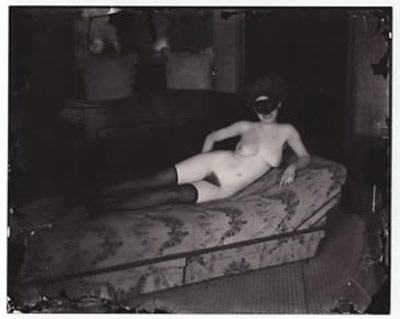Storyville Portrait, New Orleans 1911-1913 Gold toned printing out paper print Purchase, with funds from the ICP Acquisitions Committee, 2004 The Mysterious Monsieur Bellocq First of all, the pictures are unforgettable - photography's ultimate standard of value. And it's not hard to see why the trove of glass negatives by a hitherto unknown photographer working in New Orleans in the early years of this century became one of the most admired recoveries in photography's widening, ever incomplete history (Susan Sontag, Bellocq: Photographs from Storyville, 1996). Despite the great renown of his unforgettable portraits of prostitutes in the early twentieth century demimonde of New Orleans, very little was known - until recently - about the legendary photographer E. J. Bellocq (1873-1949). The International Center of Photography presents the exhibition "The Mysterious Monsieur Bellocq" to highlight the discovery of new photographs and new information about the life and work of this elusive master. The exhibition is part of the "New Histories of Photography" series conceived in collaboration with the George Eastman House in Rochester. Bellocq's photographs first came to public attention through an exhibition at the Museum of Modern Art in 1970. Photographer Lee Friedlander had originally discovered the 8 x 10 inch glass negatives in an antique shop in New Orleans. Friedlander made his own prints from the negatives using turn-of-the-century printing techniques and old printing-out paper. The plates were exposed to the printing-out paper by indirect daylight for anywhere from three hours to seven days, then the paper was given a toning bath to achieve a vintage look. At the time, John Szarkowski, then director of photography at MoMA, noted "Since none of Bellocq's prints exist to serve as models, the result might be regarded as a collaborative work." No real information was then known about the maker of the plates, so Szarkowski and Friedlander relied on interviews with various New Orleans denizens who remembered Bellocq. This speculative oral history, freely embroidered by Szarkowski in the exhibition's catalogue, presented Bellocq as a skillful primitive, who "discovered secrets" but was unaware of the importance or beauty of his work. To amplify this myth, Szarkowski cast Bellocq as a "hydrocephalic semi-dwarf, a good subject for a caricaturist, who cultivated the company of prostitutes," an image of the photographer that was perpetuated in the Louis Malle film "Pretty Baby" (1978) and persists to this day. In fact, Bellocq was a well-recognized and somewhat dapper commercial photographer in New Orleans, who practiced his trade from at least 1900, when he was twenty-six. Among his clients were a prominent shipbuilding company and the Catholic Church of New Orleans, where his brother was a priest. His photographs of prostitutes were taken around 1912 at various locations near his studio in Storyville, the New Orleans red-light district. Prostitution was legal in Louisiana at the time (until 1917, when the U.S. Navy enforced a crackdown), and Storyville was a popular neighborhood for nightlife; the area is also famous for the New Orleans jazz musicians who played there. Bellocq's intention was probably commercial rather than personal; evidence suggests that he intended the pictures of prostitutes for a guidebook to the local brothels. Bellocq photographed the prostitutes not as brazen streetwalkers, but simply and respectfully. The images are primarily single portraits, taken inside the brothels, with the women appearing quite comfortable. Young, old, thin, heavy, clothed, unclothed, seductive and relaxed - the women are at ease with themselves and with their sensuality. These were not however, the proverbial "pin-ups" or reminiscent of French postcards. The women in the photographs seem to lack self-consciousness, suggesting a warm relationship between Bellocq and the sitters. He did not glamorize or objectify his subjects; instead, he gave us a singular perception of - and a lens into - the quiet and the seductive world of Storyville. The "The Bellocq" exhibition consists of fourteen prints from the Permanent Collection of the International Center of Photography and the George Eastman House. Three of these are recently acquired rare early prints made prior to Friedlander's acquisition of the negatives, and possibly during Bellocq's lifetime. The rest are prints made by Friedlander from the original negatives. Exhibition: December 10, 2004 - February 27, 2005 Gallery hours: Tue-Thu 10 am - 5 pm, Fri 10 am - 8 pm, Sat/Sun 10 am - 6 pm International Center of Photography 1133 Avenue of the Americas @ 43rd St. New York, NY 10036 Telephone +1 212 857 0000 Fax +1 212 857 0090 Email info@icp.org www.icp.org |
|
